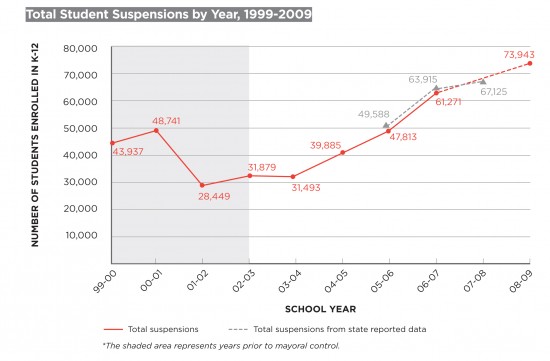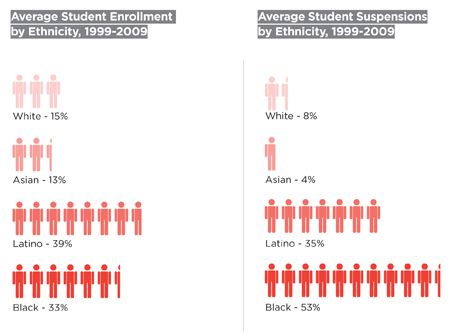The number of student suspensions in New York City public schools spiked dramatically over the past decade while the length of suspensions grew longer – a phenomenon disproportionally affecting black students and students with disabilities, according to a report released today by the New York Civil Liberties Union and the Student Safety Coalition that analyzes 10 years of previously undisclosed suspension data.
 The report, Education Interrupted: The Growing Use of Suspensions in New York City’s Public Schools, analyzes 449,513 suspensions served by New York City students from 1999 to 2009.
The report, Education Interrupted: The Growing Use of Suspensions in New York City’s Public Schools, analyzes 449,513 suspensions served by New York City students from 1999 to 2009.
The NYCLU and Student Safety Coalition obtained the raw data for the report through a series of Freedom of Information law requests to the New York City Department of Education (DOE) in 2008 and 2009. Statisticians and academics at the Annenberg Institute for School Reform at Brown University processed and analyzed the data for more than a year.
According to the data, the number of suspensions served each school year nearly doubled over the decade – even though the student population has decreased over the same period.
Among the report’s findings:
- One out of every 14 students was suspended in 2008-2009; in 1999-2000 it was one in 25. Last school year, students served more than 73,000 suspensions. In the 1999-2000 school year, students served 44,000 suspensions, even though the overall student population was much larger than today.
- Suspensions are becoming longer: More than 20 percent of suspensions lasted more than one week in 2008-2009, compared to 14 percent in 1999-2000. The average length of a long-term suspension is 5 weeks (25 school days).
- Students with disabilities are four times more likely to be suspended than students without disabilities.
- Black students, who compose 33 percent of the student body, served 53 percent of suspensions over the past 10 years. Black students with disabilities represent more than 50 percent of suspended students with disabilities.
- Black students served longer suspensions on average and were more likely to be suspended for subjective misconduct, like profanity and insubordination.
The report partially attributes the rise in suspensions to the DOE’s Discipline Code – the code of conduct for the city schools that catalogues infractions and the acceptable range of disciplinary responses for each one. From 1999 to 2010, the number of behaviors for which a student must be suspended grew by 200 percent.

